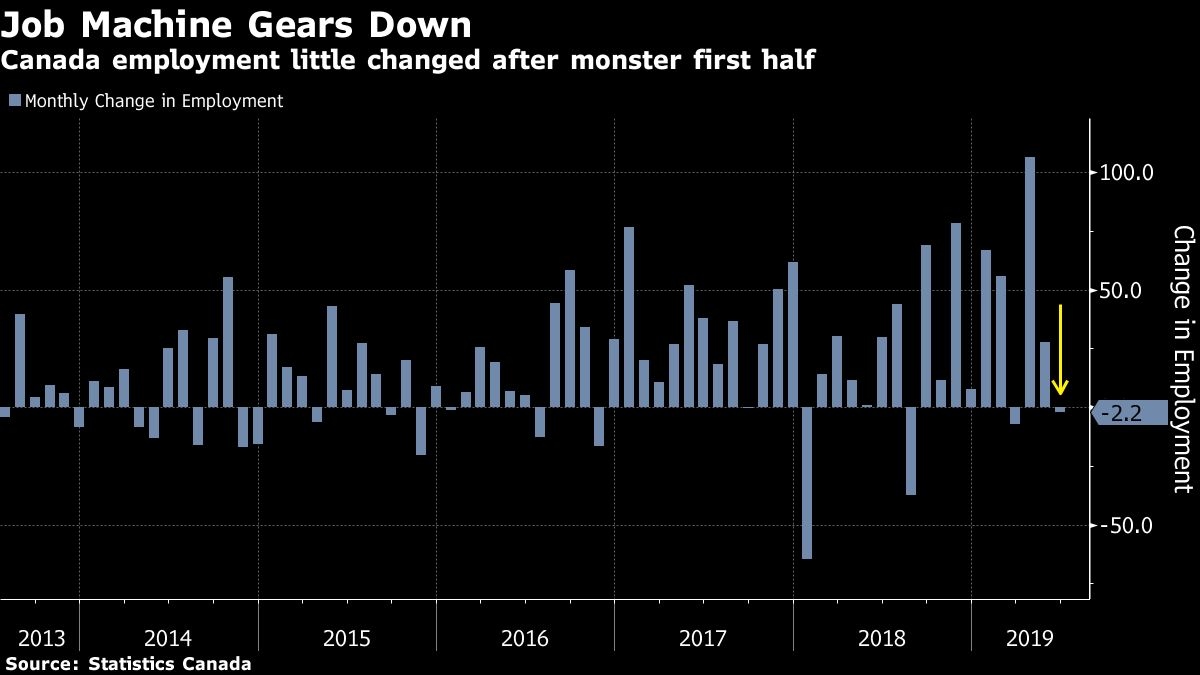Jul 5, 2019
Canada’s jobs market pauses in June after monster start to year
, Bloomberg News
Surprise drop in June jobs doesn't change the picture for the Bank of Canada: Economist
Canada’s booming labour market geared down in June, with employment little changed and a slight uptick in the jobless rate from historical lows.
The economy shed 2,200 jobs on the month, Statistics Canada said Friday in Ottawa, versus economist expectations for a gain of about 10,000. The unemployment rate rose to 5.5 per cent, after reaching a four-decade low of 5.4 per cent in May.
Even with the stall, the first half of the year was one of the best on record in terms of Canadian job gains.
Key Insights
- The flat reading for employment in June doesn’t alter the picture of a labour market that remains the main driver of Canada’s expansion, with most economists widely expecting a slowdown from its recent unsustainable pace. The economy has added 247,500 jobs since the end of last year -- the bulk of them full-time -- which is the strongest since 2002 and the second-best first-half employment gain in four decades.
- There were a number of pockets of strength in the report. Full-time jobs were up by 24,100, offsetting a decline in part-time employment. Self-employment fell, with the number of “employees” increasing. Wage gains accelerated to the fastest in more than a year.
- The fact the labor market hasn’t pulled back should bolster confidence in the sustainability of the current economic rebound and ease pressure on the Bank of Canada to cut interest rates, even if other central banks ease policy.
Market Reaction
The Canadian dollar fell after the report, which coincided the release of U.S. payroll data that topped all estimates of economists. As of 8:34 a.m. in Toronto trading, the dollar was down 0.3 per cent to $1.3094 per U.S. dollar. Yields on Canadian two-year bonds were up however, reflecting easing worries about rate cuts.
“We’ll forgive Canada’s job market for taking an early summer holiday in terms of employment gains, given the massive surge in hiring that preceded it,” Avery Shenfeld, chief economist at Canadian Imperial Bank of Commerce, said in a note.

Get More
- The one area of weakness seems to be the goods sector, which saw employment contract 32,800 in June. Half of that came from manufacturers. Employment in goods-producing industries is down by 9,400 in the first six months of 2019.
- Wages, however, are showing signs of strength. Annual hourly wages gains accelerated to 3.8 per cent in June, the fastest since May last year and up from 2.8 per cent in May. Pay gains for permanent workers climbed 3.6 per cent, also a sharp increase. The year-over- year acceleration largely reflects weakness this time last year.
- Total hours worked accelerated to 1.8 per cent from 1 per cent in May, the most since last fall.
--With assistance from Erik Hertzberg.
HAVE YOUR SAY


